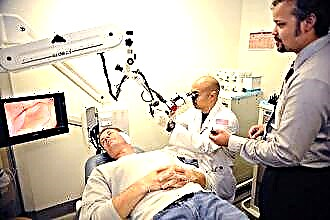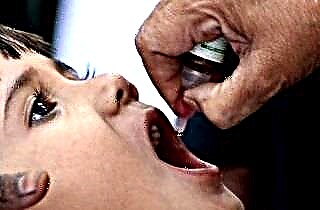Such a disease as sore throat is known to everyone. From childhood, we are taught that it can be easily picked up by breathing in the frosty air, or, for example, by drinking an ice drink in the summer heat. This can cause the main symptom of this disease - a sore throat. But do we understand correctly what angina is?
Angina, or acute tonsillitis, is an infectious disease based on inflammation of the pharyngeal ring of lymphoid tissue. Most often, with angina, the palatine tonsils are affected. This condition should be distinguished from pharyngitis (inflammation of the pharyngeal mucosa) and laryngitis (inflammation of the larynx), which are also symptoms of a sore throat.
 The name "angina" is often used in everyday life, but in medical practice this condition is usually called "scientifically" - acute tonsillitis. It should be noted that the wording "acute angina" is not used at all, since it is a tautology (the name "angina" already implies the presence of an acute inflammatory process).
The name "angina" is often used in everyday life, but in medical practice this condition is usually called "scientifically" - acute tonsillitis. It should be noted that the wording "acute angina" is not used at all, since it is a tautology (the name "angina" already implies the presence of an acute inflammatory process).
Chronic tonsillitis, unlike acute, is not a sore throat.
In this article we will tell you everything about angina - what causes it, how to diagnose this disease, how to choose an effective treatment and alleviate the patient's condition.
Sore throat symptoms
The clinical picture of acute tonsillitis is very characteristic and recognizable. Symptoms of sore throat can be divided into 2 groups - catarrhal and intoxication. Catarrhal symptoms of angina are local manifestations caused by catarrh, i.e. inflammation:
- swelling in the throat (angina is characterized by an increase in the size of the tonsils, as well as the uvula and soft palate);
- redness of the tonsils, soft palate and visible part of the pharynx;
- sharp pain when swallowing;
- the formation of mucopurulent plaque on the surface of the tonsils;
- enlargement and soreness of the lymph nodes located under the lower jaw.
It is worth noting that tonsillitis can affect the tonsils only on one side. In this case, the inflammation is more pronounced on one of the pharyngeal tonsils - it becomes larger than the second tonsil, turns red, and becomes covered with plaque. Purulent plugs can also form on only one side.
The second group of symptoms of angina is associated with intoxication of the body (literally - poisoning). Waste products of bacteria, dead cells of the body, purulent leukocyte mass - all this poisons the body. The consequences of intoxication are:
Waste products of bacteria, dead cells of the body, purulent leukocyte mass - all this poisons the body. The consequences of intoxication are:
- high body temperature (angina in adults may be accompanied by an increase in temperature up to 38-39 C, and in children, thermometer readings can exceed 39 C);
- headache;
- nausea;
- lethargy, apathy;
- loss of appetite (this symptom can also be caused by a sore throat when swallowing).
A feature of angina is its acute course - the disease begins unexpectedly, with a sharp increase in body temperature and severe sore throat.
Pronounced symptoms disturb the patient for 4-7 days and gradually decrease. It is very important to begin active treatment of angina in this short period of time in order to prevent the development of complications.
Why does your throat hurt?
At the heart of acute tonsillitis is inflammation of the palatine tonsils. The tonsils are part of the immune system. Together with other lymphoid formations of the nasopharynx, they form the pharyngeal lymphatic ring. This structure protects the body from the penetration of bacteria and viruses into the lower respiratory system. The pharyngeal tonsils are often attacked by pathogenic microorganisms, since they are constantly in contact with the inhaled air, food and drink, and therefore it is they that become inflamed more often than other lymphoid formations.
Microorganisms that enter the surface of the tonsils are destroyed due to the activity of immune cells and molecules contained in saliva, phlegm secreted by the pharyngeal mucosa, as well as in blood vessels. In unfavorable conditions (in particular, with hypothermia - general or local), the immune defense weakens, opening the gate of infection.
Viruses enter the cells of the mucous membrane, disrupting their work, and bacteria form colonies on the surface of the tonsils, accumulating in lacunae - folds on the surface of the tonsils. The destruction of body cells by foreign microorganisms triggers a cascade of defense reactions known as inflammation.
Inflammation of the tonsils is a defense reaction aimed at destroying the pathogenic microorganism and the cells infected by it. At the same time, uncontrolled inflammation can lead to hypertrophy. tonsils, cell necrosis, fever and other dangerous consequences.
tonsils, cell necrosis, fever and other dangerous consequences.
In the focus of inflammation, a large number of inflammatory mediators are released - molecules that attract leukocytes to the infected area. Leukocytes destroy not only pathogens, but also the body's own cells, infected or damaged. As a result, a sore throat patient suffers from severe sore throat.
Leukocytes that have absorbed the pathogen die; they mix with the mucus covering the tonsils, dead epithelial cells, food particles, etc., to form plaque. Plaque with a large number of leukocytes acquires a yellowish-white color and a viscous consistency; it is called purulent.
A greenish bloom in the throat that has an unpleasant odor is called necrotic. Its appearance indicates the decomposition of cells under the action of bacteria. Intensive antimicrobial treatment is urgently needed.
Causative agents of sore throat
The causative agent of inflammation of the tonsils can be various microorganisms - viruses, bacteria, less often - fungi.
Viruses are the most common cause of acute tonsillitis. Viral tonsillitis has a rapid course (3-7 days) and usually occurs in a moderate form. Among the viruses that can cause inflammation of the tonsils, the following families can be distinguished:
- adenoviruses;
- respiratory syncytial viruses;
- parainfluenza;
- Epstein-Barr virus.
It is these viruses that are responsible for most cases of acute tonsillitis, especially in childhood. The older a person is, the more resistant his immunity to viruses is. That is why in adults, adenovirus and respiratory syncytial infections are often mild and do not cause tonsillitis.
Somewhat less often, in about 30% of cases, angina is caused by a bacterial infection, primarily streptococcus. Despite the fact that streptococcus is not the most common cause of sore throat, it raises the greatest concerns, since it is streptococcal sore throat that is the most dangerous from the point of view of medicine and epidemiology.
Streptococcal sore throat has a severe course and can cause a number of complications, the most dangerous of which is rheumatism - an autoimmune destruction of the tissues of the heart, kidneys and joints.
How to understand who is the causative agent of sore throat - a virus or a bacterial infection? This can be determined using laboratory diagnostics. Some external signs of the disease can also help determine the cause of the infection, but in most cases, looking at the throat is not enough to make a diagnosis.
Diagnostic features
 If acute tonsillitis is suspected, it is strongly recommended to see a doctor. This is necessary, since self-medication of sore throat can have irreversible consequences.
If acute tonsillitis is suspected, it is strongly recommended to see a doctor. This is necessary, since self-medication of sore throat can have irreversible consequences.
The first mandatory stage of diagnosis is pharyngoscopy. This is essentially a doctor's examination of the patient's throat. During the procedure, the doctor pays attention to the size and color of the tonsils, the nature of the mucus covering them, and also palpates the anterior cervical lymph nodes.To describe the medical history with angina, information is also required about the patient's well-being, the course of the disease, contacts with infectious patients.
If the patient has a severe sore throat, the doctor usually does not send for additional research, but immediately prescribes treatment. The presence of pus, high body temperature (39 C), sharp pain when swallowing - all these symptoms indicate the bacterial nature of the disease, which allows the doctor to prescribe antimicrobial treatment.
If the bacterial nature of the infection is doubtful, it is strongly recommended to pass tests to determine the causative agent of the disease. Based on the results obtained, the doctor will select the most effective treatment.
One of the most informative tests is bacteriological culture of a throat swab. It allows you to identify the causative agent of the disease and check its sensitivity to various antibiotics. This eliminates the possibility of prescribing an ineffective antibacterial drug. This significantly reduces risks and guarantees recovery during the standard course of treatment (7-10 days). If bacteriological culture did not reveal streptococcus, the appointment of antibiotic therapy is not required.
The disadvantage of the bacteriological diagnostic method is its duration - it takes 3-5 days to get the result.
A quick and accurate diagnostic method is a general clinical blood test. This analysis allows us to judge the activity of the inflammatory process, as well as the nature of the pathogen. The key role in this is played by such indicators as:
- the number of leukocytes (with bacterial inflammation increases significantly);
- ESR (erythrocyte sedimentation rate) increases with any type of inflammation;
- the level of lymphocytes increases significantly with viral infections;
- monocytes - a significant increase in their proportion indicates an infection with EBV (Epstein-Barr virus), which has symptoms similar to angina.
A general clinical blood test is an affordable and quick test that allows you to confirm or deny the bacterial nature of acute tonsillitis.
Complex treatment of sore throat
Treatment of acute tonsillitis depends primarily on the causative agent of the disease.
So, viral tonsillitis requires standard antiviral treatment in combination with the use of antiseptic drugs for the throat - this prevents the development of complications, including the addition of a bacterial infection. Treatment for viral tonsillitis includes:
 antiviral drugs (most effective when taken on day 1-3 of illness);
antiviral drugs (most effective when taken on day 1-3 of illness);- drinking plenty of fluids;
- gargling with warm water and baking soda;
- gargle with propolis tincture;
- rinsing with a decoction of eucalyptus leaves;
- irrigation of the tonsils with an antiseptic spray;
- resorption of lozenges and tablets (has an antiseptic effect both due to the components in the composition of the preparations, and due to an increase in salivation);
- when the temperature rises above 38.5 C - antipyretic drugs (for example, Ibuprofen).
The duration of the course of treatment for viral tonsillitis is 5-7 days.
Symptomatic treatment is also used for bacterial sore throat, but it is not enough to destroy the infection. Antibiotics are the mainstay of treatment for bacterial tonsillitis.
The drugs of first choice for angina are antibiotics of the penicillin series - Flexin, Apopen, Ascillin. Amoxicillin in combination with clavulanic acid ("Amoxiclav") gives a good effect, but it is prescribed only if EBV infection is excluded in the patient - otherwise the patient develops a rash on the skin. The doctor should prescribe an antibiotic, as well as calculate the required dose and duration of treatment. In most cases, the antibiotic is taken within 10 days.
Antiseptic treatment of tonsils accelerates recovery from angina of any etiology. The safest and most effective way to antiseptically treat tonsils is to rinse the throat and irrigate the tonsils with special sprays.
It is not recommended to lubricate the tonsils with Lugol's solution and other similar means - this contributes to the spread of bacteria.
How to keep loved ones safe?
 Since angina is an infectious disease, it can be transmitted from an infected person to a healthy person. In this regard, it is necessary to adhere to the following sanitary and hygienic standards:
Since angina is an infectious disease, it can be transmitted from an infected person to a healthy person. In this regard, it is necessary to adhere to the following sanitary and hygienic standards:
- the patient must have separate dishes and cutlery;
- the patient's room must be ventilated every day (the patient must be in another room);
- kisses and other close contacts with the patient should be excluded until the symptoms disappear completely;
- after recovery, it is recommended to replace the patient's toothbrush so that he does not get infected again;
- during treatment, you should not visit crowded public places, including public transport and the place of work (it is recommended to issue a certificate of temporary disability).
Thus, angina in an adult requires close attention. This disease can be very difficult, unsettling a person for a long time.
Competent diagnosis and correctly selected treatment allows you to cure a sore throat within 7-10 days, while already on the 3-5th day the patient feels a significant improvement.

 antiviral drugs (most effective when taken on day 1-3 of illness);
antiviral drugs (most effective when taken on day 1-3 of illness);

